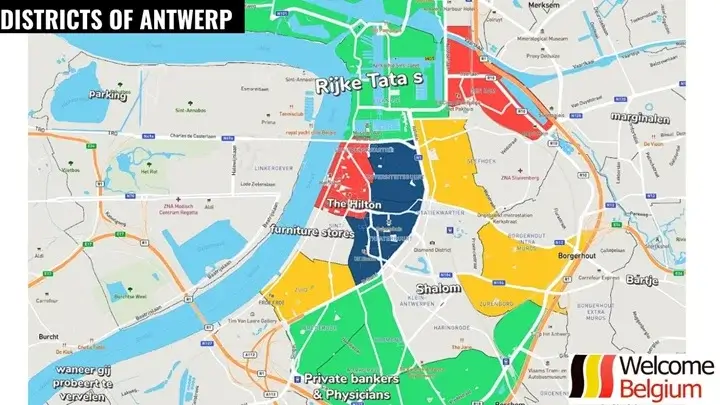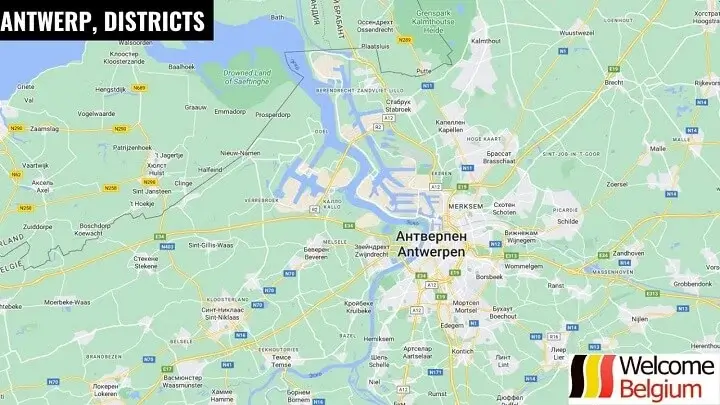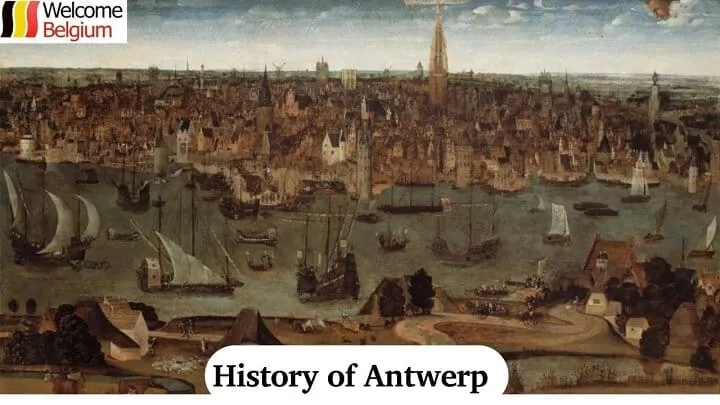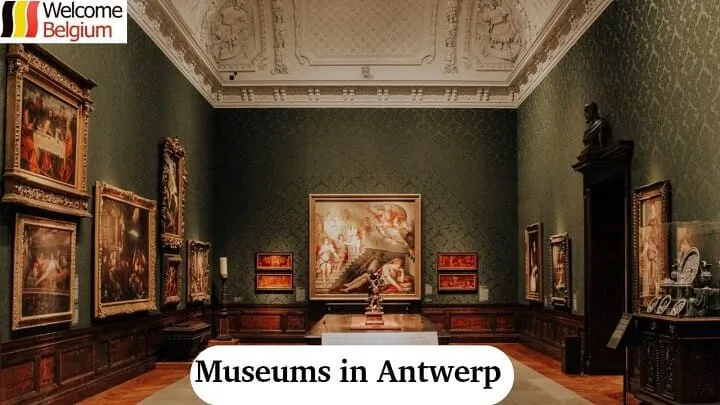Antwerp is the second-largest city in Belgium after Brussels. It combines a strong economy with a deep respect for history. The city is the administrative center of the province of the same name in Flanders. Although it was founded in the 7th century, documented historical references date back only to the 15th century.
About Antwerp’s Location
Antwerp is one of the largest cities in Belgium, located in Flanders on the banks of the River Scheldt. Thanks to its proximity to the North Sea, it has developed into a major transportation hub. The Port of Antwerp is the second largest in Europe and plays a key role in the economy of the city and the entire province.
Proximity to Brussels (just 50 km) further strengthens the region’s strategic importance. The port infrastructure has laid the foundation for the growth of heavy industry and chemical manufacturing. Energy production, including nuclear, is also expanding. These factors have made Antwerp an important industrial center in Belgium with stable economic growth.
General Information
| Category | Detail |
| Country | Belgium |
| Region | Flemish |
| Province | Antwerp |
| Population | 530,000 |
| Area | 205 km² |
| Official Languages | Dutch, French |
| Climate | Temperate continental |
Antwerp is located in the northwest of Belgium, in the Flanders region. On the country’s map, it lies along the River Scheldt, just 50 km north of Brussels. The city holds a key position at the intersection of inland and maritime transport routes, making it an essential hub in the national infrastructure. Its proximity to the North Sea supports the development of logistics and industry.
Learn more about the history of Antwerp — from the Middle Ages to the present.
The region’s natural resources include:
- Access to the sea
- A navigable river
- Favorable conditions for energy development
This creates a stable base for businesses and strengthens the city’s economic security.
Climate Features
- Temperate oceanic climate with mild winters and cool summers
- Average annual temperature: approx. +10 °C
- Coldest month: January (avg. +3 °C)
- Warmest month: July (up to +22 °C)
- Annual precipitation: around 850 mm
- Frequent rainfall during transitional seasons (especially autumn and spring)
- High humidity year-round
- Moderate westerly winds
Thanks to its geographical position, Antwerp combines:
- Access to international sea routes
- Proximity to the capital
- Natural advantages
Thanks to its geographical location, Antwerp combines access to international maritime routes, proximity to the capital, and natural advantages. All these factors make it one of the most promising regions in Belgium for industrial, transport, and economic development.
Interesting fact:
Antwerp is so close to the North Sea that its port is connected to it by a specially straightened section of the Scheldt, over 80 km long — a unique engineering artery in Europe.
Population and Districts
Thanks to its major international seaport and the intersection of key trade routes, Antwerp has become one of the most multicultural cities in Belgium. Over 170 nationalities are represented in the metropolis, which is an absolute national record.
Ethnic communities create a unique cultural environment, preserving the traditions, cuisine, and customs of their countries. This makes Antwerp an attractive tourist destination: you can taste national dishes from almost all over the world and experience the traditions of various cultures.
Main districts of Antwerp:
- Antwerpen
be/district-antwerpen-1
Address: Mechelsesteenweg 216, city centre
The central district, including the Old Town, shopping streets, museums, and historical buildings. It is the tourist and cultural heart of the city, home to the Cathedral of Our Lady, the zoo, the main square, and the central station. - Berchem
be/district-berchem-1
Address: Grotesteenweg 150, southeast
Known for its art nouveau architecture, quiet residential areas, and good transport links. Considered a creative and cosy district with parks, cafés, and galleries. - Borgerhout
be/district-borgerhout
Address: Turnhoutsebaan 92, east
A densely built, multicultural district with a strong ethnic atmosphere. Famous for Turnhoutsebaan street — a commercial and social hub with international cuisine. - Deurne
be/district-deurne-1
Address: Maurice Dequeeckerplein 1, east
A green district with residential areas, the large Rivierenhof park, and well-developed infrastructure. Suitable for families and those preferring a quieter urban life. - Ekeren
be/district-ekeren-1
Address: Veltwijcklaan 31, north
A residential and partially industrial district near the port. It combines historic buildings, villas, recreational zones, and business activity. - Hoboken
be/district-hoboken-1
Address: Marneflaan 3, south
Located south of the centre, associated with the city’s industrial heritage. A district with a strong working-class history, parks, and affordable housing. - Merksem
be/district-merksem-1
Address: Burgemeester Jozef Nolfplein 1, northeast
Located between the city centre and the port. A mixed-use area with housing, shops, and sports facilities. Well connected by public transport. - Wilrijk
be/district-wilrijk-1
Address: Bist 1, south
A southern district known for its greenery, peaceful atmosphere, and high-quality housing. Home to Planckendael Zoo and the University of Antwerp. - Berendrecht-Zandvliet-Lillo (B.Z.L.)
be/district-berendrecht-zandvliet-lillo
Address: Antwerpsebaan 140, northwest
The northernmost and least populated district. It houses part of the port infrastructure as well as historic villages with a rural character. - Borsbeek (joining as the 10th district in 2025)
be
Address: Frans Beirenslaan 5, east
A suburb previously an independent municipality. A quiet residential area with parks, schools, and charming housing.
Unlike other major cities in Belgium, Antwerp’s districts do not exhibit strong ethnic or religious divisions. The city is welcoming to immigrants in their initial integration stages — the labour market is active, with many jobs in logistics, construction, services, and manufacturing. Antwerp is also considered a convenient starting point for obtaining Belgian citizenship.
Learn more about popular museums in Antwerp.
Historical background:
Antwerp originally developed as a fishing village in the 12th century. Thanks to its favourable location on the Scheldt River, it quickly grew into one of Northern Europe’s key trade and cultural centres during the Renaissance. In the 16th century, it became a global hub for the diamond trade — a status it maintains to this day.
Municipality of Antwerp
The Municipality of Antwerp is the administrative body responsible for governing the city and ensuring the well-being of its residents. It performs a wide range of functions focused on infrastructure development, social services, and maintaining public order.
Visit the cathedrals and churches of Antwerp.
Main departments of the municipality and their functions:
- Social Welfare Department — support for low-income residents, assistance for families and the elderly
- Urban Planning Department — development and implementation of urban improvement and development projects
- Housing Department — management of municipal housing, quality control, and relocation
- Immigration and Integration Department — support for immigrants, document processing, adaptation and training programs
- Culture and Sports Department — organization of cultural events and development of sports infrastructure
- Public Health Department — disease prevention, medical services, and sanitary control
- Ecology and Environment Department — environmental monitoring and implementation of ecological initiatives
Special attention is given to working with immigrants. Antwerp has a dedicated department that helps newcomers adapt to the city, offering consultations on registration, education, employment, and civil rights. Integration programs are aimed at easing social and cultural entry into Belgian society.
Contact details of the Municipality of Antwerp:
- Website: antwerpen.be
- Address: Grote Markt 1, city center
- Phone: +32 3 338 47 11
- Working hours: Monday–Friday, 8:30 AM – 5:00 PM
The Municipality of Antwerp plays a vital role in ensuring a high quality of life and comfort for all city residents. Thanks to efficient organization and a focus on social matters, including immigrant support, Antwerp continues to grow as a modern, multicultural, and welcoming city.
Transport in Antwerp
Antwerp has a well-developed transportation system that ensures convenient mobility for both residents and tourists. The city lies at the crossroads of important railway and highway routes and is connected to international air traffic.
Main modes of transport in Antwerp:
- Public transport — includes trams, buses, and suburban trains operated by the company De Lijn; the network covers the entire city and suburbs, offering convenient connections
- Rail transport — Antwerp Central Station (Antwerpen-Centraal) is considered one of the most beautiful in the world and is a major hub with direct trains to Brussels, Bruges, Liège, and international destinations
- Road transport — Antwerp is located on a key European transport corridor, intersected by motorways E19, E17, and others
- Bicycle transport — the city has an extensive cycling infrastructure with dedicated lanes and bike rental services, encouraging eco-friendly mobility
- Port transport — Antwerp’s major port handles shipping and freight transport, linking the city to the North Sea and global maritime routes
Transport service contacts:
- De Lijn website: delijn.be
- Central station address: Koningin Astridplein 27, city center
- Info line phone: +32 3 227 72 11
- Working hours: Monday–Friday, 7:00 AM – 8:00 PM
Antwerp’s advanced transport system contributes to economic growth and quality of life, making the city accessible and convenient for both residents and visitors. Thanks to modern solutions in public and green mobility, Antwerp continues to strengthen its status as one of Europe’s leading cities.
Economy and Industry of Antwerp
Antwerp is one of the leading economic centers of Belgium and Europe due to its strategic location and strong industrial base. The city is renowned for its large port, chemical industry, diamond trade, and developed service sector.
Visit Antwerp International Airport.
Main sectors of the economy and industry:
- Port of Antwerp — the second largest in Europe, providing thousands of jobs in logistics, shipping, and freight transport;
- Chemical industry — home to major chemical plants and oil refineries;
- Diamond industry — a global center for diamond cutting and trade, a significant part of the city’s economy;
- Service sector — finance, retail, tourism, information technology, and creative industries;
- Small and medium-sized enterprises — an important part of the economy supporting diverse employment opportunities.
The average salary in Antwerp varies by sector but is approximately 3,200 euros per month (gross), which is above the Belgian average. The standard of living is considered high thanks to developed infrastructure, quality education, and healthcare.
For immigrants, Antwerp offers broad employment opportunities across various fields, including industry, services, and technology. The municipality actively supports integration programs focused on adaptation and training, facilitating successful social and economic integration of newcomers.
Contacts for employment information and immigrant support:
- VDAB Employment Service website: vdab.be
- Address: Provinciehuis, Mercatorstraat 70, city center
- Phone: +32 3 240 56 00
- Working hours: Monday–Friday, 8:30 AM – 5:00 PM
The economy and industry of Antwerp form the foundation for the city’s stable development, creating conditions for a high quality of life and new career opportunities, making it attractive for residents and immigrants worldwide.





Pingback: Antwerp: Belgium’s Historic Port City with a Modern Flair — Welcome to Belgium